A study found that two early prominent intervention models for autism had a similar impact. The researchers looked and compared toddlers with autism who got one year of 1-on-1 intervention sessions (EIBI) or (ESDM) developmental and symptom improvements. What they found out was that the effect did not differ 15 or 25 hours per week.
When parents get their first diagnosis they ask for treatment and how many hours should it be. This study is the first to respond to these questions experimentally. This study found that neither the intensity of intervention nor the type of it led to significant differences in the children’s progress.
EIBI & ESDM interventions
These two interventions vary in their underlying theories and delivery style. EIBI uses simple and structured instructions to teach children and is based on applied behavior analysis. ESDM is based on behavioral sciences and developmental with an interactive style in everyday activities, routines, and play.
Studies have shown that EIBI and ESDM treatments result in significant gains in language, learning, cognitive and adaptive skills in children. Even that number of hours per week has been based on assumptions and not scientific evidence.
We did the trial to get answers about treatment intensities on the child’s progress over time. They enrolled 87 toddlers with autism from 1 year to 2 and a half. They were randomly assigned to the intervention groups 15 or 25 hours of EIBI and 15 or 25 hours of ESDM.
They delivered a full year of one-on-one treatments in homes. All the treatments were delivered at the highest quality.
They strictly followed dhe manuals and the principles of each treatment. Even parents were coached to use everything in everyday activities.
More intervention hours does not say that is necessarily better. Both models provided great results for children.
This study was provided by University of California.






